|
Monday, December 3, 2007
Progress Notes
A week or so ago I featured the work Ron Helton was doing rehabilitating the old jail
and courthouse in Tuscumbia. I provided photos of the old jail (photo 01) constructed in the early part of the last century.
However, the first jail authorized by the County Court according to records we have as
recorded by Clyde Lee Jenkins in his book, "History of Miller County" V I p. 80,
was built in 1840. It was located north of the courthouse and across the street from where
the present Christian Church is now (photo 02).
Hardin M. Williams was appointed by the county court to superintend the erection of a jail
for the county. It was to be a log building nineteen by nineteen feet. The place provided
for the dangerous criminals was known as "The dungeon" which was partly below
the level of the ground. "The dungeon" received its light through three grated
windows, each ten inches square. The entry to it was by means of trap doors. The second
story of the wall above the level of the ground was the debtors' room.
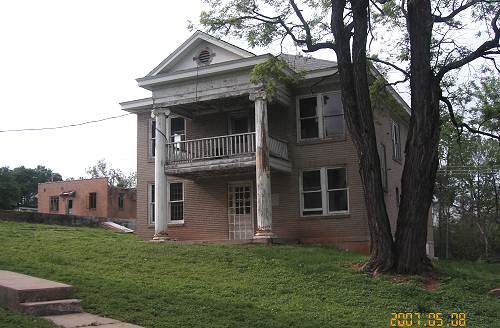
01 Old Jail
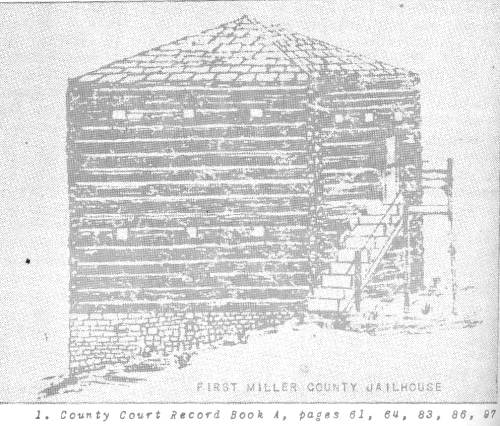
02 First Miller County Jailhouse
In 1865, according to Peggy Hake, a second jail was built in the courtyard. The exact
location is unknown. Possibly, it may have been located in the southwest corner of the
courtyard where Ron Helton, who was mentioned above, has found evidence of the remains of
a concrete and stone foundation. In 1879, one cell of it was leased to the town of
Tuscumbia for a calaboose. We have found this photo in our old files which I believe is
the second jail to which Peggy refers and also to which the "Goodspeed History of
Miller County" (1889) records as having been constructed (photo 3)
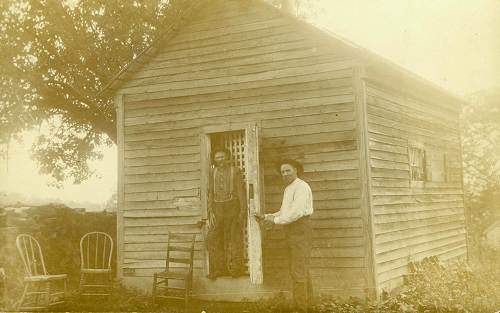
03 Second Miller County Jail
John Harvey, Prisoner; Sam Jackson, Jailer
The third jail was finished in 1929 at a cost of 10,000 dollars (photo 4). It was a two story building and was constructed of
concrete and stone, and had a length of 48 feet and a width of 30 feet. The first floor
was wholly taken up by the prisoner's' quarters, there being quarters for both men and
women prisoners. The second floor served as the residence of the Sheriff and was modern
for the times in every respect. This jail was considered one of the most modern in the
state and was equipped with steam heat, running water, and electric lights. This is the
jail that Ron Helton is rehabilitating now.
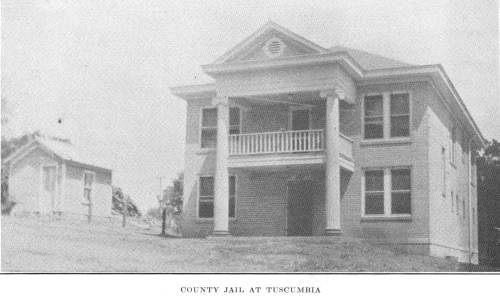
04 Third Miller County Jail
The fourth jail is the one finished a few years ago located next to the new courthouse
on highway 52 north of Tuscumbia. Our museum is close by just north of the courthouse.
I asked Peggy Hake if she would give us a summary of what she believed to be the story
on the Miller County Jails. Here is what she emailed me:
"Joe, It appears there have been 4 county jails since the county was organized
in 1837. The first one was built about 1839 and was located across the road from where the
Christian Church is sitting today..............the second one was built about 1865 on
Courthouse Square (the exact location is probably a mystery right now, but I don't think
it was located where the 3rd jail is built on the Square). The two-story building, that is
still standing today, was began in 1928 and finished in 1929. The new jail was built just
a short time ago and is next to the museum.
Ron Helton may be right about the location of the 2nd jail that was built in 1865.
I have been up and down that sidewalk so many times to the east of the courthouse but
never paid any attention to a stone wall or foundation located there! I used to park my
car on the east side of the courthouse and walked up the old sidewalk about every day that
I spent as a judge/commissioner and never once noticed anything other than a broken
sidewalk ! ! !"
But the first jail in Tuscumbia (photo 5)
actually may have been the hut like structure located along the river bank below the hill
in Tuscumbia which the photo indicates was built in 1840. It probably was a
"calaboose" built by the village solely for the temporary lockup of drunks and
disorderly individuals, especially since that area of town had three different drinking
establishments which were very busy on Saturday nights.
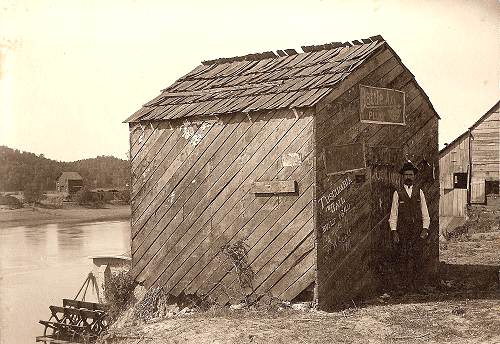
05 Tuscumbia Jail Built in 1840
I asked Peggy Hake if she had seen this photo before and if she had any comments. This
is her response:
"Joe,
I have looked at this old photo and have tried to figure out what it is! I have a theory,
but it may be far-fetched. Perhaps this is the original old jail (first built on top the
hill across the road from today's Christian Church) and for some reason it was moved down
near the river. Was it to be preserved as a historical site? There is a name on the side
that says "___W. Scott, 1911". In the census of 1900 there is a man living in
Equality Township near Tuscumbia named James W. Scott who was 35 years old and a widower
with a son, Walter E., age 13. It is so exasperating to have something like this on hand
and not have a clue what it was or what its history is!
Peggy"
On the other hand, maybe the caption on the photo indicating it was a jail was a joke
and instead this small building could have been a privy. I say this because it is known
that a privy was present many years ago at this approximate location. It was said to be
near the old blacksmith shop where the main street river road makes the turn into the
Crackerneck area going north. This privy was mentioned in Arthur and David's conversation
printed here a week or two ago when they were discussing the McGowan Brothers' Shootout.
On the other hand the building in the photo is larger than the usual two hole privy
commonly used at the time. So, I invite readers to let us know if they have any
information about this small structure which sat along the river bank in Tuscumbia many
years ago.
As a result of our newsletter and website, a number of out-of-town as well as local
friends have "discovered" the Miller County Museum for the first time. Some have
made special trips to the museum this fall to visit the museum or obtain information for
research. In a way this is absolutely wonderful! On the other hand, ironically, we are
completely reorganizing the museum in coordination with the incorporation of the use of
our new facility preparing for a "grand opening" next year. Thus, at this time
all of our displays have been disassembled and moved to storage. Therefore, we temporarily
are unable properly to accommodate these visitors, some of whom have traveled a long
distance even from out of state. We hate to disappoint these visitors so I wanted to let
everyone know that the museum temporarily is under redesign and revision. We hope everyone
will come back in the spring when we are ready to show off our new look. We think it's
going to be very special. That doesn't mean, however, that we are not scheduling and
holding our regular museum meetings because we have made a special effort to make ready
for these events our dining and meeting facility of the lower level of the new building
addition. It is beautifully decorated for Christmas as I write this week's Progress Notes.
So everybody is welcome, for example, to come to our Christmas Potluck Dinner at 1: 00
P.M. Sunday December 9.
One consequence of our efforts to redesign the museum with new themes and displays
which has required the take down and disassembly of all our exhibits is that we routinely
are coming across long ago forgotten or lost "treasures." Early on, almost
thirty years ago when the museum first opened, we received ledgers, records, diaries, and
old photos which sometimes, for one reason or another, were filed away and forgotten, or
were placed deep within the confines of one of the more detailed exhibit displays.
Although all items donated to or acquired by the museum were recorded in an
"accession file," it is very long and detailed and isn't something one normally
sits down to read unless one is looking up a special item. Some of the treasures we have
found were placed in the middle of an old book or ledger from a business, and were not
necessarily related to the business but were personal in nature. One of these
"finds" we have discovered are a couple of personal journals of C.B. Wright,
past president of the Anchor Milling Company (photo
6), written near the end of his life in 1953. The journals (photo 7) are different than C.B. Wright's diary, which was
written over a long time span beginning in 1912 continuing until 1929. Homer Clay Wright,
C.B.'s son (photo 8), thirty years ago
or so, began submitting portions of his father's diary to the Miller County Autogram.
These excerpts of history of the river boats, commerce, and people of the area were very
popular among the Autogram's readers. However, until now, no one knew about the personal
journals C.B. kept during the last two years of his life. These are not diaries but a
series of narratives in which C.B. records his memories according to subjects and themes.
For example, he covers the subject of "The Coming of Good Roads,"
"Neighborhood Picnics," "Bridges," "Doctors and Lawyers,"
and several prominent family names and their progeny.
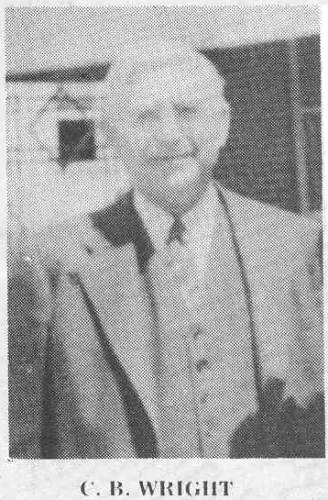
06 C. B. Wright |
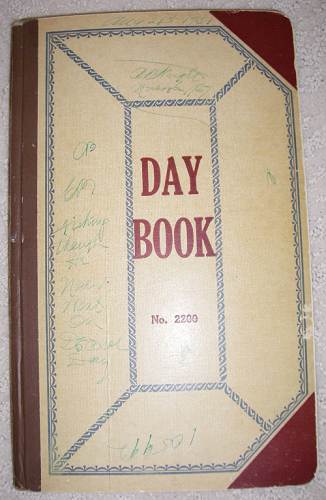
07 C. B. Wright Day Book |
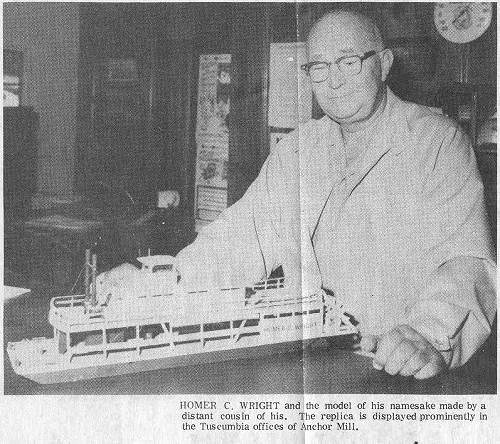
08 Homer Clay Wright
We already have placed on our website some entries from these recently discovered
journals of C.B. Wright. One is a very detailed and interesting discussion of the old
carding mill owned and operated by James Lawrence Wright, C.B.'s grandfather: http://www.millercountymuseum.org/wrightdiaries.html
Another interesting essay by C.B. on our website concerns the history of his mother's
family, the Boyces' (you will have to scroll down the page on this site due to the
alphabetical organization of the names): http://www.millercountymuseum.org/people/bio_b.html
For the next few weeks I will transcribe some of these entries to this page since they
offer some interesting historical insights about the Tuscumbia of the early last century.
But first I am inserting here a short biography of C.B. Wright that his son Homer Clay
Wright wrote to accompany the introduction of his father's diary to the public by the
Vernon Publishing Company about thirty years ago:
"My dad, Clarence Boyce Wright, was born three miles north of Tuscumbia on the
Little Saline creek, the first child of Green Lee and Emma Boyce Wright (photo 8a of Green Lee Wright family; C.B. sitting on right, Green Lee sitting in middle).
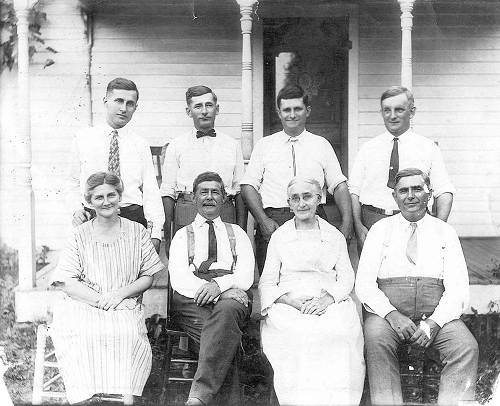
08a Family of Green Lee Wright; C.B. sitting on right, Green Lee sitting in middle
He was a self educated man; his formal education consisted only of
grade school and terms at Teachers Institute at Spring Garden and Columbia, Mo. His first
job was teaching school in the Blue Springs area near Bagnell for $25 per month. In August
of 1891 he began working for Anchor Milling Company in the flour mill and as clerk on the
Steamer J. R. Wells (photo 9).
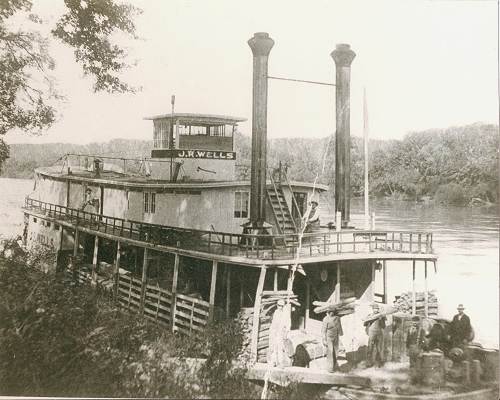
09 Steamer J. R. Wells Loading Firewood
In 1905 he married May Hauenstein, daughter of Philip and Sarah Riggins Hauenstein.
One son, Homer Clay, was born to this union in 1911. The Anchor Milling Company sold the
Steamer Wells in 1909 and bought the gasoline powered Ruth (photo 10) from Mr. Wells. The Ruth was originally built as a
pleasure craft for the Wells family and was named for one of Mr. Well's daughters. C.B.
Wright was the pilot as well as the clerk on the Ruth, which was kept very busy for the
next 10 years, including the World War I era.
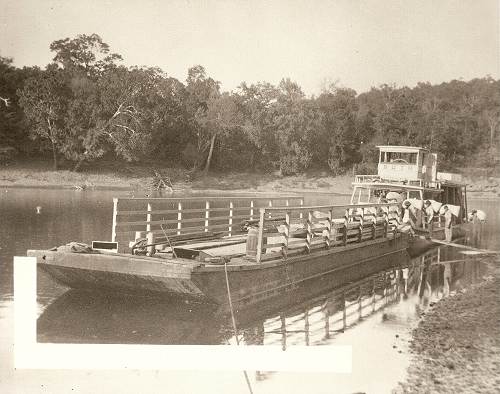
10 The Ruth
The Ruth was replaced by the Steamer Homer C. Wright (photo 11) in 1919 and named by Phil Hauenstein for his
grandson, Home Clay Wright. C.B. Wright was also pilot on the Homer Clay Wright until the
boat was sold to Union Electric in 1923, thus having spent 25 years on the river.
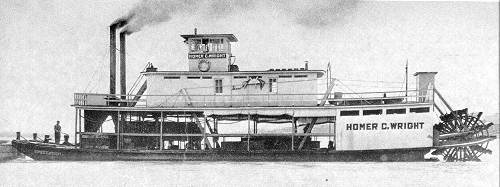
11 Homer C. Wright Steamboat
My dad was a civic minded and progressive person; he was a member of the Christian
Church and taught the young people Sunday School class for many years. He served on the
school board and town board, played in the Tuscumbia Band, and was one of the promoters
for the winter Lyceum courses and summer Chautauqua in the 1920's. He worked for the
Liberty Bond drives in World War I speaking for the drive at country schools in the area.
He was one of the promoters that originated the Annual Tuscumbia Picnic and later the
Men's Club that met in the 30's and 40's, He and D.F. Thomson were the contractors who
built the brick school building in Tuscumbia and the first Miller County Nursing Home. He
had the first car in Tuscumbia, a 1914 T model Ford. On his 70th birthday, Nov 14, 1947 he
became bedfast for almost six years until his death in 1953. During these years, he wrote
extensively about his life on the Osage, events that happened in Tuscumbia and the county,
and the history of early Miller County families. He hoped to have this material published
in book form but this was not to be, so we think he would be pleased that the Advertiser
and Miller County Autogram-Sentinel are running excerpts from his diaries."
C.B. wrote the two journals mentioned above during his last three years of life. He
rarely left his attractive brick home (photo 12)
on High Street in Tuscumbia during those last years of his life.
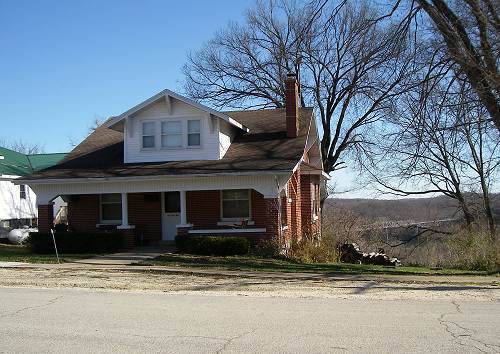
12 C. B. Wright Home
As you might be able to see from the photograph, the rear of his house faced south east
giving a wonderful view of the Osage River valley and the highway 52 bridge which crossed
the river headed south. Possibly, the river and valley he could see below his house as he
sat looking out the window of his parlor inspired him as a former steam boat captain to
want to record the many memories of his life:
Roads and Travel (from a personal journal of C.B. Wright)
C.B. WRIGHT
Before the advent of the motor car, this county had no improved
roads of any consequence, and for the most part, country people had only the farm wagon as
a means of transportation. Now and then a farmer would own a spring wagon, hack or buggy.
Jack (J.R.) Wells had a carriage with a covered fringe around the top. Dad had bought a
hack several years before the motor car. While Richard and Homer Lee Wright were still at
home (brothers of C.B.) they cut up a sizeable load of walnut logs for which they got
about $125.00. A storm on the creek had blown down a few good walnut trees and that was
one of the reasons for them wanting to harvest the logs. It took the boys a good long time
to get the load out of the woods and haul it on a large wagon to Eugene. With part or all
of this money they bought a buggy and aside from what the Wells folks had it was the only
one in the school district. John Kallenbach, who was one of our best wagon makers, had
built a heavy hack or spring wagon for his own use which was rather exceptional for the
area and quite admired. Some other community may have had more or less of what I described
above but our district was probably about on the average.
And there was not much prospect shown by the county to help us
have a good roads system other than some of the main routes which were barely maintained.
Because of the lack of funds to enable the county to build roads for the farmer, most any
landowner, if he decided to make a road or a road change, could go to the county court
with a petition which usually was granted without requiring supervision. All the farmer
had to do was clear the timber out for the proposed road…and lo! It was a road. The
most flagrant case of this sort was pulled off by some of the Artz family. They cut out a
road, or I mean the right of way, for about one half mile of timber of right good size.
The cut out road ran south from near the Musser Tavern mostly on the downgrade, then
making a corner, running one half mile east to make a connection with the old road. At
that time the Tuscumbia mail was coming to us via West Aurora. But this road change made
the neighbors more or less angry or sore because it caused the mail route to miss their
properties.
When the farmer wanted to go visiting or picnicking he loaded the
wife and kids in the farm wagon…the bed being first filled with hay, straw or other
wise. If the weather was cold, hot bricks were put in too. The kids would have quilts to
cover and that was the way they went."
When going to picnics such as the one in Aurora Springs there
would be good big crowd there already in the morning because to get home before night fall
everyone wanted to leave early.
The issue of roads was very important to the citizens of Miller County in the early
part of its history. So it is understandable that C.B. Wright would want to record some of
his own memories regarding how people dealt with modes of travel in the early part of his
life. You can read more about the subject on our website where is discussed some of the
first efforts to build new roads where before none existed or were very primitive: http://www.millercountymuseum.org/highways.html
Another article about some of the old trails in the south part of the county is at
another location at this location on our website: http://www.millercountymuseum.org/oldtrails.html
The best source for the history of roads in Miller County is volume 1 of Clyde Lee
Jenkins book, "The History of Miller County" p. 90-118. Even with all the early
effort to secure a road system for the county, Clyde Lee ends by writing the following:
"On these pioneer trails through the wilderness, farm produce
in the county found an outlet, by slow and tedious haulage across the hills and hollows,
to the Osage River. In fact, until the coming of the railroad in the early 1880's, the
inhabitants of Miller County could not have profited in surplus grain and livestock had it
not been for a navigable river flowing through the county."
One of my interests is exploring the stories of the physicians of Miller County of
fifty years or more in the past. I have already presented the histories of the two Shelton
physicians of Eldon, Edward and his son Olney (see the archives at the bottom of this
page, 8/1/2007) as well as the story of Dr. Marshall Humphrey (archives 5/25/2007) who
practiced in Tuscumbia. This week I would like to review the story of Douglas Hord Kouns
M.D. (photo 13) who practiced in
Tuscumbia for a total of about fifty years (one source reports a time span of forty seven
years and another reports his practice covered a total of fifty two years). His practice
must have been one of the longest in Tuscumbia as well as Miller County.
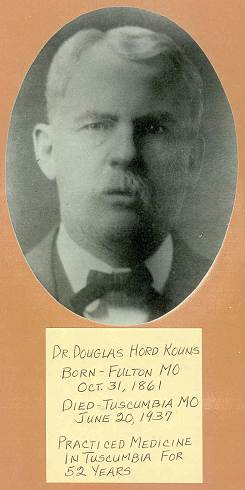
13 Dr. Douglas Hord Kouns
Not a lot is known about Dr. Kouns currently. His children married and moved away, or
at least their descendents did, because I have found that as time goes on, fewer and fewer
people remember him and it is difficult to obtain much biographical detail about his life,
especially before he came to our county. His obituary records the following information:
Iberia Sentinel (headline) June 24, 1937 Dr. D. H. Kouns of
Tuscumbia Succumbs to Illness (June 20) Dr. Kouns Had Practiced Medicine in Tuscumbia for
47 Years; Was the county's Oldest Practicing Physician
Dr. D. H. Kouns of Tuscumbia died at his home early Sunday evening
after a short illness. He became ill Thursday afternoon, June 17, and died Sunday, June
20, at 10:45 p.m. Dr. Kouns was the oldest practicing physician in Miller County being
near 77 years of age at the time of his death and having practiced in Tuscumbia for the
past 47 years. Dr. Kouns was born in Fulton, Missouri, on Oct. 31, 1860. He grew to
manhood there and graduated from Westminister College in about 1883 after which he
attended and graduated from the Kentucky School of Medicine at Louisville, Kentucky. He
be- gan his practice of medicine at Linn Creek where he met and married Lena Bell
Churchill in 1887. In 1890 he moved to Tuscumbia and practiced his profession up until the
day of his last illness. He was probably the most widely known physician in the county at
the time of his death. Dr. Kouns leaves surviving him his widow, six children and seven
grandchildren. The names and addresses of the surviving children are as follows: Mrs. Fred
Hauenstein of Exeter, California, Mrs. L. L. Simp- son of Chicago, Ill.; Churchill Kouns
of Walnut Creek, California; Mrs. Charles I. Wright of Centralia, Mo.; Mrs. James D.
Blackburn of Drumright, Oklahoma, and Clarence Kouns of Tuscumbia. Funeral services were
conducted at the Presbyterian church by the pastor, C. Smutz of Crocker, Tuesday June 22,
1937, at 2:30 p.m. The eight surviving members of the Miller County Medical Association
were pall bearers. They are as follows: Dr. W. L. Allee, Dr. G. D. Walker, Dr. E. C.
Shelton, Dr. E. O. Shelton, Dr. James Allee, all of Eldon and Drs. G. W. Duncan and F. C.
Suggett of Iberia. Interment was in the Tuscumbia Cemetery.
It was through Bamber Wright that we obtained a photo of Dr. Kouns. Bamber's
grandfather was William H. Hauenstein Jr. whose first son, Fred Hauenstein, married Dr.
Kouns' daughter, Mary. The couple left this area many years ago to settle in California.
The wife of their son, Fred Hauenstein Jr., is still living in California and is the one
Bamber contacted to get us a copy of a photograph of Dr. Kouns. As noted above, although
Dr. Kouns practiced in Tuscumbia for forty seven years, little biographical information is
available and it was especially difficult to find a photograph of him in our files.
Over the time of his practice Dr. Kouns lived in three different houses. The first was
a framed house still standing located to the north of the George Hauenstein home at the
entrance to the baseball park in the Goosebottom area of town. The second home was located
on the north side of Goosebottom street immediately to the right after crossing the Shut
In Branch crossing. That house no longer is standing. The third home was in the
Crackerneck area of east Tuscumbia. It was a large three story house but no longer is
standing.
Several people who lived in Tuscumbia when Dr. Kouns practiced have at one time or
another left some written record of their memories of him. For example, a few weeks ago on
this webpage Arthur and David Bear gave us some anecdotal information about Dr. Kouns:
David: Well, the country was full of characters through
the years, and we'll come back to that at another sitting. Let's come back to the doctors
for just a moment. I don't know what kind of training they had in those days, but
certainly not anything like we have today. I don't know how many courses the med schools
had for doctors in training, but from the kind of medicine I saw practiced, it probably
wasn't many. They knew how to sew up wounds like a person would get at a Saturday night
dance when the knives were wielded. Doc Kouns sewed up many of these, but not always in a
sterile fashion. These doctors did have a good knowledge of symptoms, and could often tell
you what disease you had, but there were no very effective medicines available for
treatment. They were usually conscientious persons with an interest in people, but were
limited by the state of the art of their profession. These doctors made house calls in
town, and were always on call to go out to farm houses to minister. Babies were born at
home usually with a doctor present. These early doctors made their rounds riding either on
horseback or in a buggy. Doc Kouns bought a model T. Ford, probably in the early twenties.
Catfish Williams drove it for him. Doc was a big man and probably was afraid to drive one
of those horseless carriages. Often these doctors would stay up all night with a patient.
Doctors of his time pulled teeth, performed minor surgery, and set broken bones. Much of
their pay was in eggs, poultry, hams, etc. Much of it was on credit and often the doctor
never got paid. Doc Kouns urged some of his farm customers not to eat ham for health
reasons but, instead pay their doctor bill with it. I remember one year I had a terrible
pneumonia. I was so sick I cannot to this day remember all the details. But one thing I do
remember is that Dr. Kouns came into my bedroom everyday to check on me before he went to
his office at the bank and he also would check on me on his return home.
Bamber Wright remembers that Dr. Kouns daily would walk to his office located on the
second floor of the bank building with his hands in the back pockets, usually smoking a
"Little Chancellor" cigar. Bamber says that Dr. Kouns always greeted him by
saying "Hi kid!" According to Bamber although he had a car, Dr. Kouns didn't
drive, but engaged Charles (Catfish) Williams to drive him for night and emergency calls.
My mother, Susie (Bear) Pryor, remembers Dr. Kouns very well because his first house
mentioned above was located behind the house in which she lived in the Goosebottom area.
He was the doctor who had delivered her in the family's old house on the Bear farm located
on Dog Creek south of the Osage River. I asked her to write for me her memories of Dr.
Kouns and she sent by email the following:
Recently my Son asked me to write down what I remembered
about Dr. Kouns who was our local Doctor. He & Mrs. Kouns lived right in the back of
me & my folks in the part of Tuscumbia called Goose Bottom & I visited them often.
Through the eyes of a five year old he was huge & when he walked he sort of shuffled
along. In fact he sort of looked like an old Country Doctor. One day I was over there
& he gave me some cookies & we visited & I decided it was about time for me to
go home. Dr. Kouns asked me why I didn't just stay over there & be his little girl. I
thought for a moment & then asked him why didn't he just keep me when he had me? I
guess at that young age I just thought that he delivered all the young babies & gave
them to their Mothers. I might not have remembered that story if every body hadn't
laughed.
I was too young to stay at home alone so since my Mother
had to work every day in our family store she took me with her so I spent a lot of time
down there. When I got bored I visited in the homes of all the towns' people plus riding
my tricycle & skating all the way up & down the sidewalks that ran from one end of
town up to the other. I always wondered why I couldn't go into the building marked
Johnson's Saloon. As yet I couldn't read the signs but I knew I never saw women in there.
But I did see Dr. Kouns go in there & that made me wonder more than ever. Also there
were a couple of sisters around l2 or l3 that I would see come out of there each carrying
a double-decker ice cream cone. They came in town on Saturdays & I knew there was a
little bit of ill-repute associated with that store. Here they would walk down the street
to our store carrying these ice cream cones & my mouth would just water. Nobody else
in town at that time sold ice cream or hamburgers except Johnson's Saloon. I didn't know
what was the attraction for Dr. Kouns. When I got a little older I could read signs &
I figured out why I wasn't allowed to go in there. However, I know now that a lot of
people went in there to get ice cream cones because that was something new and no one else
in town sold them.
Later Dr. Kouns & Mrs. Kouns moved out of Goose Bottom
to get out of the flooding area. The lower part of Tuscumbia was built following the banks
of the Osage River & sometimes it would get out of its banks & flood the whole
bottom area all of the streets & homes & businesses were flooded as it passed its
way through town. Well, Goose Bottom was flooded first of all & then it would keep
spreading higher & higher & would crest leaving the higher places exempt. They
thought they would be safe from the floods if they bought a house located down in Cracker
Neck for it was built a little higher up on the hill. Their house was at the end of the
street & they were neighbors to the Fendorf house & across the street the home of
Carrie Wright, T.C. Wright & Lawrence Wright's Mother who was a Milliner (hat maker).
There were other homes on both sides of the street. I was well acquainted with all those
folks down in that neighborhood & since I had visited the Kouns when they lived behind
me over in Goose Bottom I continued to visit them down there too.
Tuscumbia had the first high school built among the areas
which had elementary schools but no higher education for those that wanted to go to high
school. So there were quite a few of them that rented rooms in town & attended high
school. I vaguely remember visiting a couple girls that had rented a room upstairs in Mrs.
Kouns house. I may not have it exactly right but it seemed to me that I was in the room of
Connie Buster & Nell Scott. But it makes more sense to say that Connie's room mate was
her sister, Rosena. I just remember visiting two girls in their room. I thought that was
big stuff going to high school. And I remember Mrs. Kouns having a bed in her living room.
I thought perhaps to clear a room upstairs to rent. Mrs. Kouns was a very domestic lady
& their furnishings were very much like every one else's in town.
I can't seem to remember having Dr. Kouns taking care of
me for any medical problem but I'm sure he did for that spanned several years of my life.
Doris (Wright) Clemens has given us her memories of Dr. Kouns in her autobiography,
"Life…A Trail of Memories," a copy of which we have in our museum library:
"Doc Kouns, a resident of Goosebottom, was an icon of
the community. A symbol of loving care for his ailing fellow men, he was a huge man with a
booming voice. His large feet thump, thumped as he walked. Every small town had its
country doctor. One of the most amusing stories about Doc Kouns happened during an Osage
River flood: The Kouns family home in Goosebottom was one of the first to be flooded when
the river overflowed. Furniture on the lower floor was moved upstairs. A John boat was
tied up to a porch post at the front door. Doc dragged out his old gum boots. In early
stages of the flood he waded to and from town. When it got deeper he used the boat, but
someone else always rowed. One day on the way to town Doc became unbalanced standing in
the boat and fell into the back water. His boots rapidly filled with water and he was
being sucked under. He could have drowned but for the quick work of his companions. Doc
Kouns made house calls. He traveled the community in a Model T Ford, a two passenger run
about. His chauffer was Charley (Catfish) Williams. Doc rode with his right foot on the
running board. This was in case his driver had a wreck so he could easily eject himself.
When he arrived he didn't knock at your door. He just opened it, stomped in and boomed
"Anybody home?" But Doc Kouns always seemed able to help us even if it was just
with calomel or castor oil. We loved and respected our town doctor"
The other day as I was driving down the Tuscumbia Eugene road I saw a couple of
sycamore trees extending their branches across the road (photo 14). If "X" marks the spot, I thought to
myself, I ought get out of the car and walk a little closer to get a look. My photo might
be captioned "dueling sycamores." Maybe you can think of something else. At any
rate, you can see that I don't have that much to do anymore.
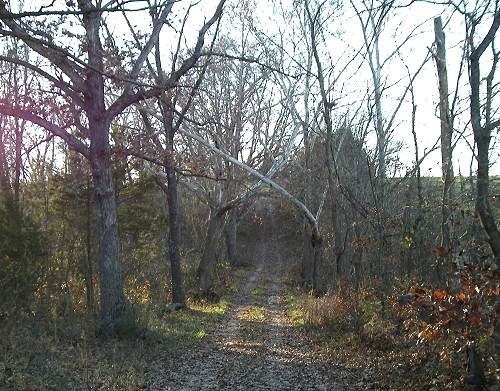
14 Dueling Sycamores
Well, I did go to a car show in Kansas City this last weekend with my brother in law,
Paul Holder and a friend of Paul's, Aaron Chapman (photo
15). They had a 1969 GTO (photo 16)
they were selling at the show (successfully accomplished) and I went around the Kemper
arena taking some pictures of some of the cars (photo
17). A number of interesting people were encountered at the show (photos 18,19,20).
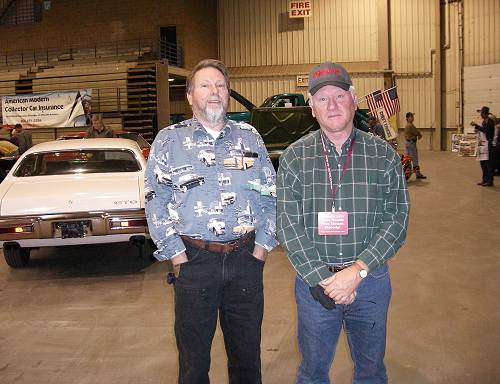
15 Paul Holder and Aaron Chapman
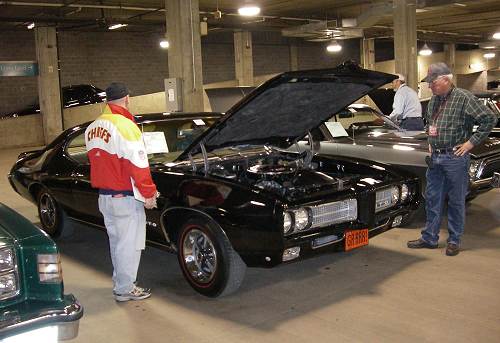
16 1969 GTO
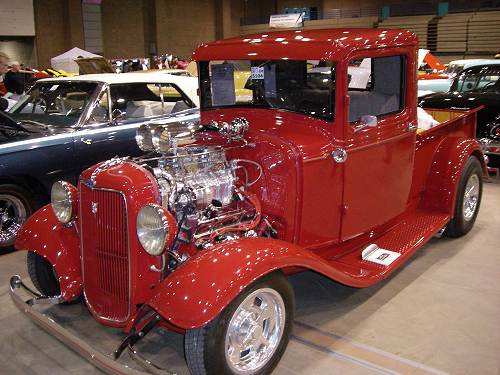
17 Model A Pickup
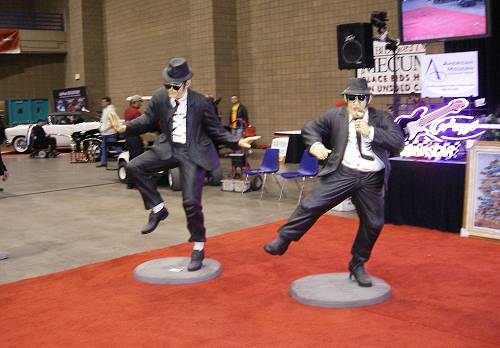
18 Blues Brothers
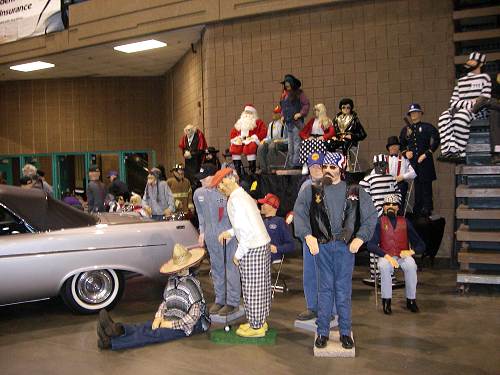
19 Car Enthusiasts
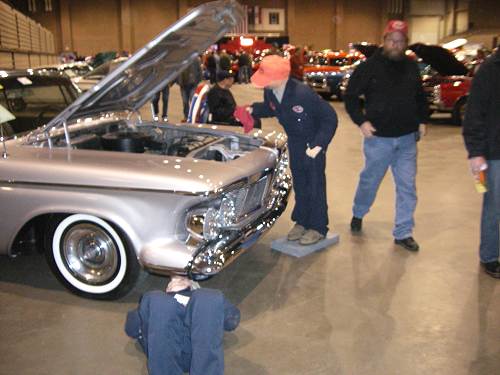
20 Loco Mechanics
Our next meeting at the museum is the Christmas Potluck Dinner on Sunday, December 9
beginning at 1:00 P.M. Entertainment is planned as well. The dinner will be served in our
new dining and meeting facility on the lower level. We hope you can come to be with us.
Everyone is invited. Christmas decorations are already in place. It is really nice to have
a new facility as modern as this one to hold our meetings. We are really grateful to the
community for the outpouring of support which financed the new addition's construction. We
do solicit continued financial support for the purchase of modern office equipment such as
a computer, special storage shelves for valuable old documents and office file cabinets to
improve our research library. The library is very important to many people including out
of town visitors who come to Tuscumbia solely for the purpose of researching their family
histories in our many files and documents. You can help us with these purchases by a tax
deductible donation sent to this address:
Miller County Building Fund
P.O. Box 57
Tuscumbia, Mo. 65082
That's all for this week.
| 


